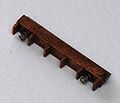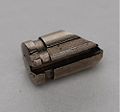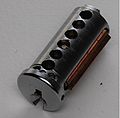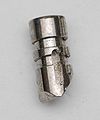Medeco Biaxial: Difference between revisions
No edit summary |
m (corrected plug measurement) |
||
| (8 intermediate revisions by 5 users not shown) | |||
| Line 6: | Line 6: | ||
| maker = [[Medeco]] | | maker = [[Medeco]] | ||
| lock_type = [[Cylinder]] | | lock_type = [[Cylinder]] | ||
| lock_design = [[Pin-tumbler]], [[Sidebar]] | | lock_design = [[Pin_tumbler |Pin-tumbler]], [[Sidebar]] | ||
| years_produced = 1985-present | | years_produced = 1985-present | ||
| patent = [ | | patent = [https://patents.google.com/patent/US4635455A/ US 4,635,455] | ||
| related = [[Medeco Original]]<br>[[Medeco | | related = [[Medeco Original]]<br>[[Medeco M4]]<br>[[Medeco Duracam]] | ||
| spec_on = true | |||
| spec_comptype = [[Pin_tumbler |Pin-tumbler]] | |||
| spec_comp = 5 or 6 | |||
}} | }} | ||
The '''Biaxial''' is a [[UL 437]] rated [[pin-tumbler]] lock made by [[Medeco]]. It is well known for the use of rotating bottom (key) pins that interface with a [[sidebar]]. The Biaxial is one of the most widely used American [[high security locks]]. It was previously thought to be one of the most secure locks available, but continued research from the [[locksport]] community has proven a variety of attacks are possible, including [[key bumping]]. | The '''Biaxial''' is a [[UL 437]]-rated [[Pin_tumbler |pin-tumbler]] lock made by [[Medeco]]. It is well known for the use of rotating bottom (key) pins that interface with a [[sidebar]]. The Biaxial is one of the most widely used American [[high security locks]]. It was previously thought to be one of the most secure locks available, but continued research from the [[locksport]] community has proven a variety of attacks are possible, including [[key bumping]]. | ||
The Biaxial is a newer version of the [[Medeco Original]] and has since been superseded by the [[Medeco M3]]. The [[Medeco Duracam]] is a [[dimple]] lock form of the Biaxial. | The Biaxial is a newer version of the [[Medeco Original]] and has since been superseded by the [[Medeco M3]]. The [[Medeco Duracam]] is a [[dimple]] lock form of the Biaxial. | ||
| Line 58: | Line 61: | ||
== Disassembly instructions == | == Disassembly instructions == | ||
Disassembly of the Biaxial is simplified compared to other sidebar-based locks because there are no additional finger pins used in the sidebar. | Disassembly of the Biaxial is simplified compared to other sidebar-based locks because there are no additional finger pins used in the sidebar. The diameter of the plug is 12.966mm. | ||
{{Pin-tumbler standard disassembly}} | {{Pin-tumbler standard disassembly}} | ||
| Line 66: | Line 69: | ||
== Vulnerabilities == | == Vulnerabilities == | ||
The Biaxial may be vulnerable to one or more of the following: | |||
* [[Lockpicking]] | * [[Lockpicking]] | ||
| Line 73: | Line 78: | ||
'''Notes''' | '''Notes''' | ||
* The validity of key bumping attacks against Medeco cylinders has been debated between Medeco and the [[locksport]] community. Research done by Marc Weber Tobias and Tobias Bluzmanis has shown these systems are vulnerable to a wide variety of attacks, including bumping. | * The validity of key bumping attacks against Medeco cylinders has been debated between Medeco and the [[locksport]] community. Research done by [[Marc Weber Tobias]] and Tobias Bluzmanis has shown these systems are vulnerable to a wide variety of attacks, including bumping. | ||
* Lockpicking attacks against this lock were previously thought extremely difficult due to axial rotation. A tool called the "Medecoder", developed by Jon King, made this process much easier and at the same time allowed for decoding of the sidebar code.<ref>King, Jon. [http://www.theamazingking.com/medecoder. | * Lockpicking attacks against this lock were previously thought extremely difficult due to axial rotation. A tool called the "Medecoder", developed by Jon King, made this process much easier and at the same time allowed for decoding of the sidebar code.<ref>King, Jon. [http://www.theamazingking.com/medecoder.php The Amazing King - Medecoder]</ref> | ||
== Gallery == | == Gallery == | ||
| Line 84: | Line 89: | ||
File:Medeco_Biaxial_cylinder_sidebar.jpg|Biaxial cylinder with [[sidebar]] inserted. | File:Medeco_Biaxial_cylinder_sidebar.jpg|Biaxial cylinder with [[sidebar]] inserted. | ||
File:Medeco_Biaxial_bottom_pin_chisel.jpg|Biaxial bottom pin showing chisel and sidebar notch. | File:Medeco_Biaxial_bottom_pin_chisel.jpg|Biaxial bottom pin showing chisel and sidebar notch. | ||
File:Medeco_Biaxial_ARX_micro_milled.jpg|A micro-milled ARX pin that defends against picking and decoding attacks. | |||
File:Medeco_Biaxial_pins.jpg|Pins used in a five pin Biaxial. | File:Medeco_Biaxial_pins.jpg|Pins used in a five pin Biaxial. | ||
File:Medeco_Biaxial_sidebar_aligned.jpg|Sidebar pins properly aligned, side view. | File:Medeco_Biaxial_sidebar_aligned.jpg|Sidebar pins properly aligned, side view. | ||
| Line 95: | Line 101: | ||
* [[Medeco]] | * [[Medeco]] | ||
* [[Pin-tumbler]] | * [[Pin_tumbler |Pin-tumbler]] | ||
* [[Sidebar]] | * [[Sidebar]] | ||
| Line 102: | Line 108: | ||
[[Category:Sidebar locks]] | [[Category:Sidebar locks]] | ||
[[Category:Medeco|Biaxial]] | [[Category:Medeco|Biaxial]] | ||
[[Category:Axial rotation]] | |||
[[Category:Lock models]] | |||
Latest revision as of 12:31, 4 March 2023
Medeco Biaxial
| Medeco Biaxial | |
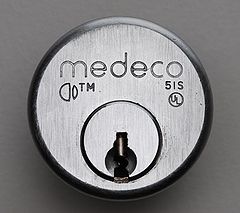 | |
| Name | Medeco Biaxial |
|---|---|
| Manufacturer | Medeco |
| Lock Type | Cylinder |
| Lock Design | Pin-tumbler, Sidebar |
| Year(s) Produced | 1985-present |
| Patent | US 4,635,455 |
| Specifications | |
| # of Components | 5 or 6 |
| Component Type | Pin-tumbler |
| Related Locks | |
| Medeco Original Medeco M4 Medeco Duracam | |
The Biaxial is a UL 437-rated pin-tumbler lock made by Medeco. It is well known for the use of rotating bottom (key) pins that interface with a sidebar. The Biaxial is one of the most widely used American high security locks. It was previously thought to be one of the most secure locks available, but continued research from the locksport community has proven a variety of attacks are possible, including key bumping.
The Biaxial is a newer version of the Medeco Original and has since been superseded by the Medeco M3. The Medeco Duracam is a dimple lock form of the Biaxial.
Principles of Operation
The Medeco Biaxial uses five or six pin-tumblers that provide axial rotation to interface with a sidebar located at 3 o'clock. Pin-tumblers must be properly raised to the shear line as well as rotated so that the sidebar arms can fall into notches on the side of each pin-tumbler. Axial rotation is provided by the design of the bottom (key) pins and angled bitting cuts on the key. There are 6 depths available for pin-tumblers, allowing 7,776 (65) theoretical key differs in a five pin Biaxial (excluding the sidebar).
The main difference between the Biaxial and the Original is that Biaxial bottom pins sit before or after the center of the bitting cut. This allows for six total positions of the bottom pins, but pins use only three true gate positions. Biaxial pins have their own rotation codes:
| Type | Left | Center | Right |
|---|---|---|---|
| Fore (Biaxial) | K | B | Q |
| Original | L | C | R |
| Aft (Biaxial) | M | D | S |
There are 6 total positions for bottom pins, allowing 7,776 (65) and 46,656 (66) total sidebar differs in five and six pin Biaxials, respectively. True gates on the pins can only be rotated to three positions, so there are only 243 (35) and 729 (36) actual rotational differs in five and six pin Biaxials.
The Biaxial uses 2-3 mushroom top pins in each cylinder to provide manipulation resistance to traditional lockpicking. The sidebar notches on the sides of the bottom pins may also have false notches to resist manipulation by rotation. In addition, "ARX" pins are used to protect against manipulation by rotation. ARX pins close the sidebar notches before they reach the end of the pin, making it so they cannot be readily grabbed by a tool.
Resistance to forced entry is provided in the form of hardened steel rods and discs. In the plug rods are in the 3, 9, and 12 o'clock positions. In the cylinder, two crescent shaped discs are placed at the 12 and 3 o'clock positions to protect the pin-chambers and the sidebar. As a secondary locking mechanism, the sidebar itself also helps to protect against a variety of forced entry techniques. Bottom pins may also have a hardened steel core to resist drilling.
Notes
- Biaxial and Original bottom pins are not interchangeable. They are identified by the position of the flag that limits rotation. The flag is 90° from the true gate in the Original and 180° in the Biaxial.
- The Biaxial can be identified by the the Biaxial logo (a split circle) to the left of the keyway.
Disassembly instructions
Disassembly of the Biaxial is simplified compared to other sidebar-based locks because there are no additional finger pins used in the sidebar. The diameter of the plug is 12.966mm.
- Remove the cam or C-clip.
- Insert the key and turn the plug 45-90 degrees.
- Withdraw the plug from the cylinder. (A plug follower is recommended)
OR
- Remove the chamber casings and take out each pin-stack individually
- Remove the cam or C-clip.
- Withdraw the plug from the cylinder.
Notes
- When reassembled the sidebar must be pointed down, with the ball bearing facing the front of the plug.
Vulnerabilities
The Biaxial may be vulnerable to one or more of the following:
Notes
- The validity of key bumping attacks against Medeco cylinders has been debated between Medeco and the locksport community. Research done by Marc Weber Tobias and Tobias Bluzmanis has shown these systems are vulnerable to a wide variety of attacks, including bumping.
- Lockpicking attacks against this lock were previously thought extremely difficult due to axial rotation. A tool called the "Medecoder", developed by Jon King, made this process much easier and at the same time allowed for decoding of the sidebar code.[1]
Gallery
Biaxial cylinder with sidebar inserted.
References
- ↑ King, Jon. The Amazing King - Medecoder

